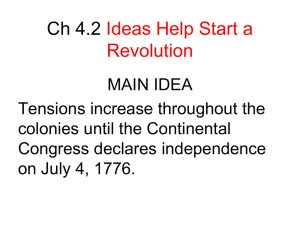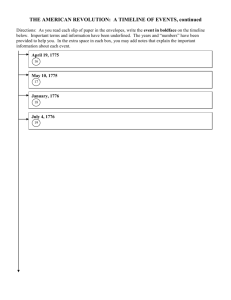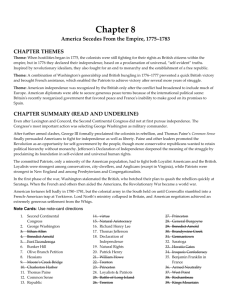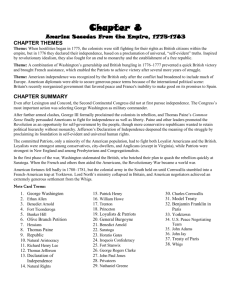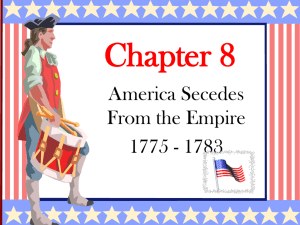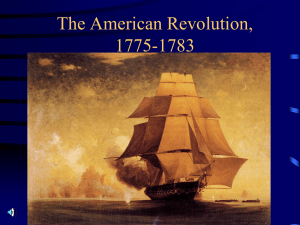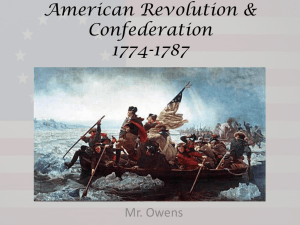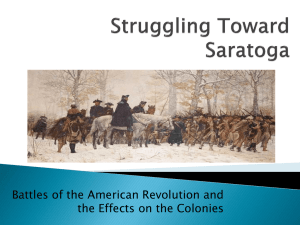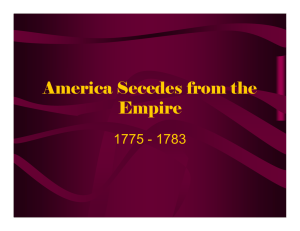Chapter 8-present - apush
advertisement
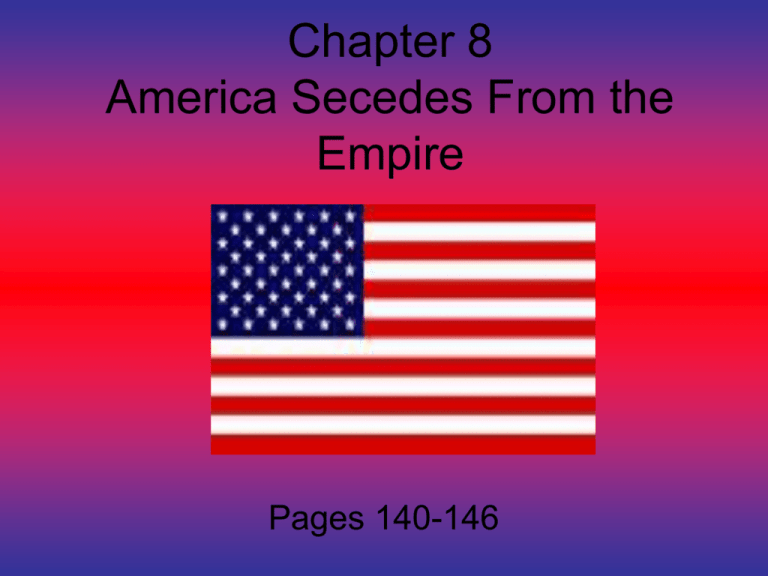
Chapter 8 America Secedes From the Empire Pages 140-146 CHAPTER THEMES Theme: When hostilities began in 1775, the colonists were still fighting for their rights as British citizens within the empire, but in 1776 they declared their independence, based on a proclamation of universal, “self-evident” truths. Inspired by revolutionary idealism, they also fought for an end to monarchy and the establishment of a free republic. Theme: A combination of Washington’s generalship and British bungling in 1776–1777 prevented a quick British victory and brought French assistance, which enabled the Patriots to achieve victory after several more years of struggle. Theme: American independence was recognized by the British only after the conflict had broadened to include much of Europe. American diplomats were able to secure generous peace terms because of the international political scene: Britain's recently reorganized government that favored peace and France's inability to make good on its promises to Spain. Congress Drafts George Washington • After the bloodshed at Lexington and Concord in April of 1775, about 20,000 Minutemen swarmed around Boston, where they outnumbered the British. • The Second Continental Congress met in Philadelphia on May 10, 1775, with no real intention of independence, but merely a desire to continue fighting in the hope that the king and Parliament would consent to a redress of grievances. • It sent another list of grievances to Parliament. • It also adopted measures to raise money for an army and a navy. • But in perhaps the most important single action, the Second Continental Congress also selected George Washington to command the army. – Washington had never risen above the rank of colonel, and his largest command had only been of 1,200 men, but he was a tall figure who looked like a leader, and thus, was a morale boost to troops. – He radiated patience, courage, self-discipline, and a sense of justice, and though he insisted on working without pay, he did keep a careful expense account amounting to more than $100,000. Bunker Hill and Hessian Hirelings • In the first year, the war was one of inconsistency, as the colonists maintained their loyalty while still shooting at the king’s men. • In May 1775, a tiny American force called the Green Mountain Boys, led by Ethan Allen and Benedict Arnold, surprised and captured the British garrisons at Forts Ticonderoga and Crown Point – The importance of this raid lay in the fact that they captured much-needed cannons and gunpowder. • In June 1775, the colonials seized Bunker Hill (previously known as Breed’s Hill). – Instead of flanking them, the Redcoats launched a frontal attack. – After Captain William Prescott urged his soldiers, “Don’t fire until you see the whites of their eyes!”, the heavily entrenched colonial sharpshooters mowed them down until their meager gunpowder supplies ran out, and they were forced to retreat. • After Bunker Hill, George III slammed the door for all hope of reconciliation and declared the colonies to be in open rebellion, a treasonous affair. • The king also hired many German mercenaries, called Hessians, who, because they were lured by booty and not duty, had large numbers desert and remained in America to become respectful citizens. The Abortive Conquest of Canada • In October 1775, the British burned Falmouth (Portland), Maine. • The colonists decided that invading Canada would add a 14th colony and deprive Britain of a valuable base for striking at the colonies in revolt. – Also, the French-Canadians would support the Americans because they supposedly were bitter about Britain’s taking over of their land. – General Richard Montgomery captured Montreal. – At Quebec, he was joined by the bedraggled army of Gen. Benedict Arnold. – On the last day of 1775, in the assault of Quebec, Montgomery was killed and Arnold was wounded in one leg, and the whole campaign collapsed as the men retreated up the St. Lawrence River, reversing the way Montgomery had come. – Besides, the French-Canadians, who had welcomed the Quebec Act, didn’t really like the anti-Catholic invaders. • In January 1776, the British set fire to Norfolk, Virginia, but in March, they were finally forced to evacuate Boston. • In the South, the rebels won a victory against some 1,500 Loyalists at Moore’s Creek Bridge, in North Carolina, and against an invading British Thomas Paine Preaches Common Sense • In 1776, Thomas Paine published the pamphlet Common Sense, which urged colonials to stop this war of inconsistency, stop pretending loyalty, and just fight – in a nutshell, it called for American independence and the creation of a democratic republic. • Nowhere in the universe did a smaller body control a larger one, so Paine argued, saying it was unnatural for tiny Britain to control gigantic America. • He called King George III “the Royal Brute of Great Britain.” Paine and the Idea of “Republicanism” • Paine argued his idea that there should be a “republic” where representative senators, governors, and judges should have their power from the consent of the people. • He laced his ideas with Biblical imagery, familiar to common folk. • His ideas about rejecting monarchy and empire and embrace an independent republic fell on receptive ears in America, though it should be noted that these ideas already existed. – The New Englanders already practiced this type of government in their town meetings. • Some patriots, though, favored a republic ruled by a “natural aristocracy.” Jefferson’s “Explanation” of Independence • Members of the Philadelphia 2nd Continental Congress, instructed by their colonies, gradually moved toward a clean break with Britain. • On June 7, 1776, fiery Richard Henry Lee urged for complete independence, an idea that was finally adopted on July 2, 1776. • To write such a statement, Congress appointed Thomas Jefferson, already renown as a great writer, to concoct a Declaration of Independence. • He did so eloquently, coming up with a list of grievances against King George III and persuasively explaining why the colonies had the right to revolt, including: -Invoking the “natural rights” of humankind (life, liberty, and the pursuit of happiness). -an accusation that the British had violated said natural rights. -a catalog of King George III’s tyrannical actions. -an argument that royal tyranny justified revolt. • When Congress approved it on July 2nd, John Adams proclaimed that date to be celebrated from then on with fireworks, but because of editing and final approval, it was not completely approved until July 4th, 1776. Internal Division • The War of Independence was a war within a war, as not all colonials were united. – There were Patriots (“Whigs”), – Loyalists (“Tories”), – And others (Moderates and “Profiteers”) The war divided • During the war, the British families. For example, proved that they could only Benjamin Franklin was control Tory areas, because against his illegitimate when Redcoats packed up and son, William, the last left other areas, the rebels royal governor of New Jersey. would regain control. Typical Patriot (“Whig”) Samuel Adams – Supported rebellion – Generally the younger generation – The Patriot militias constantly harassed small British detachments. Typically didn’t belong to the Anglican Church (Church of England) Congregational, Presbyterian, Baptist, or Methodist. New England was the patriots’stronghold. Patrick Henry Typical Loyalist (“Tory”) Supported the king (George III) – Often went to battle against fellow Americans – Generally conservatives – Most numerous where the Anglican Church was strongest (the South) Less numerous in New England, where Presbyterianism and Congregationalism flourished More numerous in the aristocratic areas such as Charleston, SC William Franklin Others • Moderates – In the middle or didn’t care either way – Constantly asked to join one side or another. • “Profiteers” – Sold to the highest bidder, selling to the British and ignoring starving, freezing soldiers (i.e. George Washington at Valley Forge). The Loyalist Exodus • After the Declaration of Independence, Loyalists and Patriots were more sharply divided, and Patriots often confiscated Loyalist property to resell it (an easy way to raise money), tarred and feathered them, made them ride astride fence rails, imprisoned them, and exiled them……. • Though it was tough on the Loyalists, at least they weren’t murdered in a mass reign of terror that would befall the French Revolution in the ensuing years. • Some 50,000 Loyalists served the British in one way or another (fighting, spying, etc…) It was odd the Brits didn’t make more use of them during the war. General Washington at Bay • After the evacuation of Boston, the British focused on New York as a base for operations. – An awe-inspiring grand fleet appeared off the coast in July 1776, made up of some 500 ships and 35,000 men—the largest armed force seen in America until the Civil War. – Washington only mustered 18,000 ill-trained men to fight, and was routed by the British at the Battle of Long Island. • Washington escaped to Manhattan Island, crossed the Hudson River to New Jersey, reaching the Delaware River with taunting, fox-hunt calling Brits on his heels……… – After making it across the river just in time (leaving no boats for which the British to cross), Washington recrossed the Delaware River at Trenton on Dec. 26, 1776, and surprised and captured 1,000 Hessians sleeping off their Christmas Day celebration (drinking). – A week later, Washington left his campfires burning as a ruse, slipped away, and inflicted a sharp defeat on a smaller British detachment at Princeton, showing his military genius at its best. – The victories at Trenton and Princeton saved the revolutionary effort and inspired new confidence in America’s military. – Oddly (and fatefully) British Gen. William Howe did not crush Washington at the Delaware when he had his chance, but he remembered Bunker Hill, and was overly cautious. Burgoyne’s Blundering Invasion London officials adopted a complicated scheme for capturing the vital Hudson River valley in 1777, which, if successful, would sever New England from the rest of the colonies. The plan was such that… – General Burgoyne would push down the Lake Champlain route from Canada. – General William Howe’s troops in New York, if needed, could advance up the Hudson and meet Burgoyne in Albany. – A third and much smaller British force commanded by Col. Barry St. Leger would come in from the west by way of Lake Ontario and the Mohawk Valley. • However, Benedict Arnold, after failure at Quebec, retreated slowly along the St. Lawrence back to Lake Champlain, where the British would have to win control (of the lake) before proceeding. – The Brits stopped to build a huge force as Arnold gathered a ragged fleet from boats he could find. – His “navy” was destroyed, but he got valued time. Winter came and the British settled in Canada. They’d have to begin anew the next spring. • Had Arnold not contributed his daring and skill, the Brits most likely would have recaptured Ticonderoga and Burgoyne could have started from there and succeeded in his venture. • Burgoyne began his mission with 7,000 troops and a heavy baggage train made up of many officers’ wives. – Meanwhile, sneaky rebels, sensing the kill, were gathering along his flanks. • General Howe, at a time when he should be moving up the Hudson, purposely embarked to attack Philadelphia. – He wanted to force an encounter with Washington leaving the path open for Burgoyne’s thrust. He thought he had time to help Burgoyne if needed. – Washington transferred his troops to Philadelphia, but was defeated at Brandywine Creek and Germantown. – The fun-loving Howe settled down in Philadelphia, leaving Burgoyne “to the dogs.” – Ben Franklin joked Howe “Philadelphia had captured Howe” rather than vice-versa. • Washington retired for the winter at Valley Forge. His troops froze in the cold. • Prussian drillmaster, Baron von Steuben, whipped the troops into shape. • Burgoyne’s doomed troops were bogged down, and the rebels swarmed in with a series of sharp engagements, pushing St. Leger’s force back at Oriskany while Burgoyne, unable to advance or retreat, surrendered his entire force at The Battle of Saratoga, on October 17, 1777. – One of the most decisive battles in British and American history. – The importance of Saratoga was afterwards, France sensed America might actually win and came out to officially help America. The Battle of Saratoga (1777) Revolution in Diplomacy? France was eager to get revenge on Britain, and secretly supplied the Americans throughout much of the war. The Continental Congress sent delegates to France. The delegates were guided by a “Model Treaty” which sought no political or military connections, only commercial ones. – Ben Franklin played the diplomacy game by wearing simple gray clothes and a coonskin cap to supposedly exemplify a raw new America After Saratoga (An Alliance With France) • Britain offered the Americans a measure for home rule— everything they sought but independence. • France was finally persuaded to enter the war. – Louis XVI’s ministers claimed this the best time to act, b/c if Britain regained control, she might try to capture the French West Indies for war compensation. – Now was the time to strike, rather than risk a stronger Britain with its reunited colonies. – In 1778, France offered an alliance treaty with, offering everything Britain had plus recognition of independence. – The Americans accepted the agreement with caution, since France was pro-Catholic. • Since the Americans needed aid, they’d take it. The Colonial War Becomes a Wider War • In the 1779, Spain and Holland entered the war against Britain • In the 1780, Catherine the Great of Russia took the lead in organizing the Armed Neutrality that lined up all of Europe’s neutrals in passive hostility against England. The Colonial War Becomes a Wider War • When the alliance with France was formalized, the Americans were able to: – – – – gain access to large sums of money. Double the size of their fighting forces. Avail themselves of French naval strength. Gain immense amounts of equipment. French aid to the colonies: - Greatly aided America’s struggle for independence. - Was motivated by what the French considered to be their own national interests. - Forced the British to change their military strategy in America. - Helped them protect their own West Indies islands. Blow and Counterblow • Besides Washington, the main American commanders in the war were: -George Rogers Clark in the West (here in KY) -Nathanael Greene in the South -John Paul Jones at sea • French reinforcements, commanded by Comte de Rochambeau, arrived in Newport, Rhode Island in 1780, but flares sometimes erupted between the Americans and the French. • In 1780, feeling unappreciated and lured by British gold, Gen. Benedict Arnold turned traitor by plotting with the British to sell out West Point. When the plot was discovered, he fled with the British. “Whom can we trust now?” cried George Washington in anguish. The British devised a plan to roll up the colonies from the South. Georgia was ruthlessly overrun in 1778-1779. • • • • • Comte de Rochambeau • Marquis de Lafayette • George Rogers Clark • John Paul Jones John Paul Jones’ Corpse Benedict Arnold: Hero, Traitor Blow and Counterblow • Georgia was ruthlessly overrun in 1778-1779. • Charleston, South Carolina, fell in 1780. • In the Carolinas, Patriots bitterly fought their Loyalist neighbors, most notably effective was Francis Marion’s (the Swamp Fox) hit and run attacks on British detachments. • However, in 1781, Daniel Morgan’s American riflemen wiped out a British detachment at King’s Mountain, and then defeated a smaller force at Cowpens. • At the Carolina campaign of 1781, Quaker-reared tactician Gen. Nathanael Greene distinguished himself with his strategy of delay. – By slowly retreating and losing battles but winning campaigns, he helped clear the British out of most of Georgia and South Carolina. The Land Frontier and the Sea Frontier • 1777 was known as the “bloody year” on the frontier, as Indians went on a scalping spree. • Most of the Indians supported Britain and believed that if they won, it would stop American expansion into the West, and save Indian land. • Mohawk chief Joseph Brant, recently converted to Anglicanism, and his men ravaged the backcountry of Pennsylvania and New York until checked by the Americans in 1779. • In 1784, the pro-British Iroquois (the Oneidas and the Tuscaroras had sided with the Americans, the other four with the British) signed the Treaty of Fort Stanwix, the first treaty between the U.S. and an Indian nation. Simon Kenton saving Daniel Boone at the siege of Boonesboro April 24, 1777 • Even in wartime, pioneers, such as Simon Kenton and Daniel Boone, moved west, showing their gratitude to the French with such town names as Louisville while remembering the revolution with Lexington, Kentucky. • George Rogers Clark, an audacious frontiersman, floated down the Ohio River with about 175 men in 1778-1779 and captured British forts at Kaskaskia, Cahokia, and Vincennes in quick succession. • The tiny American navy never really hurt the British warships, but it did destroy British merchant shipping and carried the war into the waters around the British Isles. • Swift privateers prayed on enemy shipping, capturing hundreds of British merchant ships, forcing them to sail in convoys. • John Paul Jones & the Bonhomme Richard Engaging the Serapis in Battle • “I have not yet begun to fight!” Yorktown and the Final Curtain • Before the last decisive victory, inflation continued to soar, and the government was virtually bankrupt. It announced that it could only repay many of its debts at a rate of 2.5 cents on the dollar. • However, Cornwallis was blundering into a trap. • Retreating to Chesapeake Bay and assuming that British control of the seas would give him much needed backup, Cornwallis instead was trapped by Washington’s army, which had come 300 miles from NY, Rochambeau’s French army, and the navy of French Admiral de Grasse. Surrender of Cornwallis to Washington at Yorktown • After hearing the news of Cornwallis’ defeat, Lord North cried, “Oh God! It’s all over!” • Stubborn King George wanted to continue the war, since he still had 54,000 troops in North America and 32,000 in the U.S., and fighting did continue for about a year after Yorktown, especially in the South, but America had essentially already won. Peace at Paris • Many Brits were weary of the war, since they had suffered heavily in India and the West Indies. The island of Minorca in the Mediterranean had fallen, and the Rock of Gibraltar was tottering. • Ben Franklin, John Adams, and John Jay met in Paris for a peace deal. • Jay suspected that France would try to keep the U.S. cooped up east of the Alleghenies and keep America weak. • Instead, Jay, thinking that France would betray American ambition to satisfy those of Spain, secretly made separate overtures to London (against instructions from Congress) and came to terms quickly with the British, who were eager to entice one of their enemies from the alliance. Peace at Paris • With the Treaty of Paris of 1783, Britain formally recognized U.S. independence and granted generous boundaries, stretching majestically to the Mississippi River to the west, the Great Lakes on the north, and to Spanish Florida on the South. • The Yankees also retained a share in the priceless fisheries of Newfoundland. • For their part, the Americans agreed to not persecute Loyalists, yet Congress could realistically only recommend to the colonial legislatures that they should return or pay for confiscated Loyalist land. A New Nation Legitimized • Britain ceded so much land because it was trying to entice America from its French alliance. – George Rogers Clark had only conquered a small part of that western land, so the ceded land was quite generous. • Also, fortunately for the brand new U.S.A., the Americanfriendly Whigs were in control of Parliament at the time of the signing. • France approved the treaty, though with cautious eyes….. • In truth, America came out a HUGE winner, and seldom, if ever, have any people been so favored. Treaty of Paris 1783 CHAPTER SUMMARY Even after Lexington and Concord, the Second Continental Congress did not at first pursue independence. The Congress’s most important action was selecting George Washington as military commander. After further armed clashes, George III formally proclaimed the colonists in rebellion, and Thomas Paine’s Common Sense finally persuaded Americans to fight for independence as well as liberty. Paine and other leaders promoted the Revolution as an opportunity for selfgovernment by the people, though more conservative republicans wanted to retain political hierarchy without monarchy. Jefferson’s Declaration of Independence deepened the meaning of the struggle by proclaiming its foundation in selfevident and universal human rights. The committed Patriots, only a minority of the American population, had to fight both Loyalist Americans and the British. Loyalists were strongest among conservatives, city-dwellers, and Anglicans (except in Virginia), while Patriots were strongest in New England and among Presbyterians and Congregationalists. In the first phase of the war, Washington stalemated the British, who botched their plan to quash the rebellion quickly at Saratoga. When the French and others then aided the Americans, the Revolutionary War became a world war. American fortunes fell badly in 1780–1781, but the colonial army in the South held on until Cornwallis stumbled into a French-American trap at Yorktown. Lord North’s ministry collapsed in Britain, and American negotiators achieved an extremely generous settlement from the Whigs. Kennedy, The American Pageant Chapter 8 • The Continental Congress’s primary reason for naming George Washington commander of the army was – 1. his demonstrated military experience and skill. – 2. that he was a wealthy planter from Virginia and thus provided political balance. – 3. that he knew how to raise and train a professional army. – 4. that Washington would be more politically skilled in working with Congress than any other potential leader. • The Continental Congress’s primary reason for naming George Washington commander of the army was – 2. that he was a wealthy planter from Virginia and thus provided political balance. – See page 140. • In July 1775, after the Battle of Bunker Hill, the Continental Congress – 1. passed a resolution demanding that the British army withdraw from America. – 2. adopted a Constitution that would henceforth govern all the states. – 3. adopted an “Olive Branch Petition” declaring American loyalty to the king and begging him to find a peaceful solution. – 4. called for the complete mobilization of the militia in all the colonies to fight the British. • In July 1775, after the Battle of Bunker Hill, the Continental Congress – 3. adopted an “Olive Branch Petition” declaring American loyalty to the king and begging him to find a peaceful solution. – See page 141. • The two brilliant American generals who conducted the nearly successful invasion of Canada in October 1775 were – 1. Richard Montgomery and Benedict Arnold. – 2. George Washington and Horatio Gates. – 3. Nathanael Greene and the Marquis de Lafayette. – 4. George Rogers Clark and John Paul Jones. • The two brilliant American generals who conducted the nearly successful invasion of Canada in October 1775 were – 1. Richard Montgomery and Benedict Arnold. – See page 142. • The key development leading a majority of Americans to favor independence after January 1776 was – 1. Washington’s defeat of the British in the Battles of Trenton and Princeton. – 2. the British use of German mercenaries to try to crush the rebellion. – 3. the belief that only independence could bring France to their aid. – 4. Thomas Paine’s brilliant arguments for independence in his publication Common Sense. • The key development leading a majority of Americans to favor independence after January 1776 was – 4. Thomas Paine’s brilliant arguments for independence in his publication Common Sense. – See page 144. • Thomas Paine’s appeal for a new republican form of government attracted many Americans because – 1. they believed that social class differences promoted by monarchy were wrong. – 2. their own experience with local and colonial democratic governance had prepared them for the idea. – 3. they were impressed that Paine was drawing on the best classical ideas from Plato’s Republic. – 4. they were fearful that wealthy southern planters like Washington wanted to establish nobility in America. • Thomas Paine’s appeal for a new republican form of government attracted many Americans because – 2. their own experience with local and colonial democratic governance had prepared them for the idea. – See page 144. • Thomas Jefferson’s Declaration of Independence was most brilliant and effective in – 1. proving that King George III was one of the worst tyrants who had ever ruled a great empire. – 2. declaring that Americans were really fighting for the rights of Englishmen. – 3. appealing to France and other European countries to join the revolutionary cause. – 4. linking the cause of American independence to natural law and the universal rights of man. • Thomas Jefferson’s Declaration of Independence was most brilliant and effective in – 4. linking the cause of American independence to natural law and the universal rights of man. – See pages 145–146. • The patriot militia was most effective in – 1. its campaign of “political education” in favor of independence among ordinary colonists. – 2. its ability to defeat crack British troops in open combat. – 3. its ability to discredit and defeat the Loyalists. – 4. its campaigns against the British on the western frontier. • The patriot militia was most effective in – 1. its campaign of “political education” in favor of independence among ordinary colonists. – See page 146. • At the end of the Revolutionary War, the harshest punishments inflicted on most Loyalists were – 1. public branding or imprisonment. – 2. execution. – 3. exile or confiscation of property. – 4. being sold into slavery or indentured servitude. • At the end of the Revolutionary War, the harshest punishments inflicted on most Loyalists were – 3. exile or confiscation of property. – See page 150. • The British strategy of dividing the American colonies by controlling the Hudson River failed largely because – 1. it was not a well-considered or feasible plan. – 2. General William Howe stayed in Philadelphia rather than moving to meet General Burgoyne as was planned. – 3. George Washington foiled the plan by defeating the British in the Battles of Brandywine Creek and Germantown. – 4. the French navy prevented effective reinforcements from reaching General Burgoyne. • The British strategy of dividing the American colonies by controlling the Hudson River failed largely because – 2. General William Howe stayed in Philadelphia rather than moving to meet General Burgoyne as was planned. – See pages 152–153. • Americans believed that their new national motto, “a new order for the ages,” meant that in international affairs they would stand for – 1. the rule of law, free trade, and an end to colonialism. – 2. a new international organization that would replace the doctrine of national sovereignty. – 3. an alliance of democratic republics to overthrow tyrannical monarchies around the world. – 4. America’s entry into the system of alliances and balance of power in Europe. • Americans believed that their new national motto, “a new order for the ages,” meant that in international affairs they would stand for – 1. the rule of law, free trade, and an end to colonialism. – See page 154.

